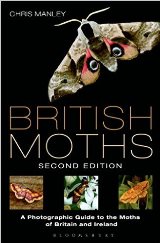British Moths
 Chris Manley
Chris Manley
Bloomsbury, £35.99
This beautifully presented book will prove useful to amateurs and serious recorders alike. The photos are clear and attractive, and cover more than 850 of the UK's larger moths ('macros') and hundreds of our smaller moths ('micros'). In contrast to many ID guides, the photos are of living moths, not set specimens.
A welcome update in this edition is the inclusion of distribution maps. Also, a size bar below each photo now shows the average size of the moth. The layout is clearer with neater text, although sadly the photos are still only labelled with the species checklist number, which then needs to be referenced with the name on the opposite page.
For those interested in micro moths, the coverage is wider than in the first edition (sometimes with photos of the 'mines' – feeding patterns in the leaves that enable the identification of caterpillars).
A helpful addition for serious recorders is the new 2013 checklist numbers, as well as the previous Bradley 2000 numbers. Some mistakes have been spotted (the Rose Tortrix, for example, is incorrect), so if you are using the book for recording purposes, you may want to inform your county recorder.
I can recommend British Moths as an attractive addition to any naturalist's bookshelf. The beauty of the photos are a testament to the amazing diversity of UK moths.


